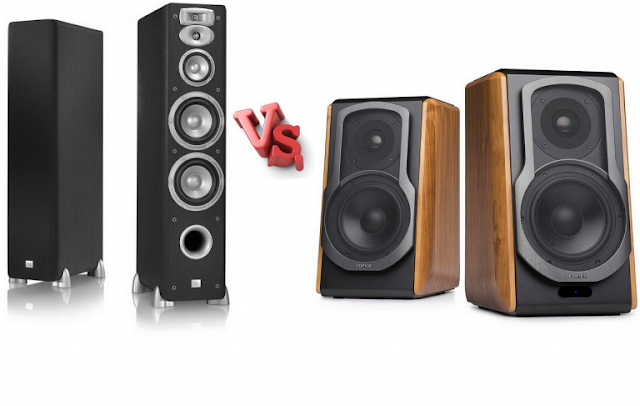WHAT ARE DIFFERENT TYPES OF SPEAKERS?
Speakers have been around for a long while and initially, they have highlighted a solitary driver and subsequently a solitary driver type.
After some time, numerous progressions have been made to make amplifiers wide, tall, noisy, bassy, etc. Nonetheless, when the audio quality has become a mission for sound architects, they have understood that sound partition is an absolute necessity.
To accomplish that, various speakers (otherwise known as. electroacoustic transducers) need to zero in on delivering various sounds. As such, to improve sound quality, every speaker should just deliver sounds inside the restricted recurrence range.
This permits the driver to practice inside the recurrence band so it doesn't have to recreate an excessive number of sounds simultaneously causing sound twisting.
Subsequently, the most widely recognized arrangement to convey the reasonable sound is to have three separate speakers where one is answerable for high-recurrence sound conveyance and the other two for mid-reach and bass individually.
To accomplish a by and large adjusted sound, the three speakers are normally positioned in a solitary walled in the area regularly alluded to as an amplifier framework. With a wide range of speakers worked in, the amplifier is normally intended to cover the full range of human hearing that goes from 20 to 20,000 Hz.
TWEETER
A tweeter is the littlest kind of amplifier that is otherwise called the high pitch speaker. The speaker is intended to replicate the maximum furthest reaches of the perceptible recurrence range. It differs between tweeters, however commonly the sound recurrence it conveys goes from 2,000 Hz to 20,000 Hz.
There are uncommon kinds of tweeters that can create sounds up to 100,000 Hz, yet those sound waves stay outside of the human hearing limit.
The term 'tweeter' comes from the word 'tweet' which addresses high pitch sounds made by certain winged creatures.
To deliver high-recurrence sounds, the stomach needs to vibrate quicker, which makes the more modest speaker size fundamental. Indeed, to deliver higher recurrence sounds, the speaker's stomach should move quicker making the size of the stomach a basic factor. Bigger drivers can't move at a quick and accordingly – not ready to produce quality high-recurrence sounds.
Current tweeter stomachs are made of silk, polyester film or texture, aluminum, and other unique composites or even titanium. The stomach is joined to the encompassing' (otherwise known as suspension) wide end which addresses a metal edge that supports cone development. It is associated with the bin utilizing an adaptable metal ring that permits curl development and keeps it safely set up.
More often than not the high pitch speakers sit inside the primary nook along with different speakers, nonetheless, there are arrangements where tweeters are intended to sit in their own semi-autonomous unit.
MID-RANGE DRIVER
A mid-range speaker is a driver that is otherwise called a squawker. It is intended to convey sound from 250 to 2000 Hz recurrence range.
More often than not the driver has a cone shape, be that as it may, you can likewise run over arch sort drivers, however, those are more uncommon.
The plan is basic, more often than not where the stomach has a voice loop joined to the neck and the cone encompass appended to the external side of the stomach.
The most widely recognized material utilized for cones of mid-range drivers is paper. Simultaneously, saps and polymers are being utilized all the more regularly now as they give preferable vibrational damping over the paper.
Across the whole solid range, mid-range speakers handle its main piece. Above all else, mid-range is regularly the busiest of all recurrence ranges as the greater part of the sounds we hear everyday fall inside that range. Likewise, due to getting mid-recurrence range sounds consistently, human ears have been prepared to perceive inconsistencies and bends easily.
Furthermore, most instruments sit, and in particular – the human voice sits inside that range, which is basic to the general sound nature of the tune or soundtrack being played. Indeed, most fundamental sound proliferation gadgets, for example, radio, TV sets, and numerous others, just have one driver which is a mid-range driver.
It is imperative to comprehend that sensible sound quality can be accomplished by just imitating center frequencies. The equivalent can't be said about high or low frequencies as in any event when being replicated together, the general sound experience conveyed won't be anyplace reasonable or listenable.
LOW RANGE OR BASS
The low reach recurrence gets repeated by woofers and sub-woofers. The word gets gotten from the canine's yelping or a 'woof', which uses lower recurrence waves, contrasted with feathered creatures 'tweeting' that involve the highest point of the audio range.
The distinction among woofers and sub-woofers is in the recurrence range they are intended to recreate with the previous ordinarily working inside the 40 Hz to 500 Hz range and the last involving sub 100 Hz frequencies.
Most shopper grade amplifiers join woofers and sub-woofers into a solitary speaker, yet as you climb in the sound constancy, those two get isolated for a cleaner, cleaner, and more refined low-recurrence sound.
WOOFER
A woofer likewise called a bass speaker is a term for amplifier or a driver entrusted with replicating low-recurrence sounds.
More often than not, it includes an electrodynamic driver made of solid paper or different polymers.
With the least finish of human hearing being around 20 Hz, woofers don't ordinarily deplete human hearing capacities working in the 40 Hz and upwards range.
With some amplifier frameworks, the reach covered by a woofer stretches out to 3000 Hz or even 5000 Hz. Those speakers are called 'mid-woofers' and are commonly found in home theater frameworks where the sub-woofer comes in its own fenced-in area. From a functional perspective, they leave the lower proliferation to sub-woofers and take on the woofer and mid-range speaker recurrence conveyance. Contact KLH Audio for a custom plan proposed to facilitate your stand-out tendency.







Comments
Post a Comment